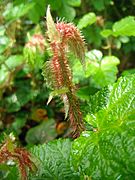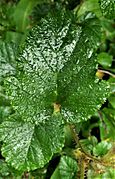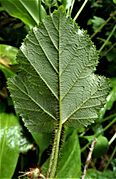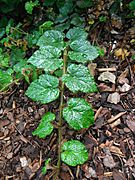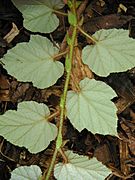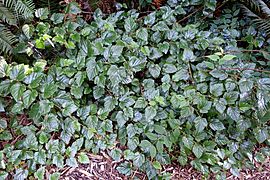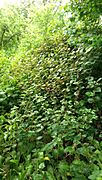Rubus tricolor facts for kids
Quick facts for kids Rubus tricolor |
|
|---|---|
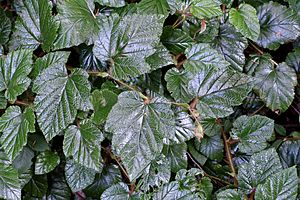 |
|
| Scientific classification | |
| Genus: |
Rubus
|
| Species: |
tricolor
|
| Synonyms | |
|
|
Rubus tricolor (say it: ROO-bus TRY-kuh-ler) is a special plant. It's an evergreen shrub that grows low to the ground. This plant comes from southwestern China. Its leaves are dark green on top and light green underneath. The stems have cool red bristles. In summer, it has white flowers. Then, it grows tasty red fruit.
This plant usually grows about 0.3 meters (1 foot) tall. It spreads out quickly, forming a thick mat on the ground. People often use it in gardens to cover the soil. Some common names for it are Chinese bramble, groundcover bramble, and Korean raspberry. In China, it's called 三色莓, which means "three-colored berry."
Contents
What Does Rubus tricolor Look Like?
How the Plant Grows
Rubus tricolor usually grows along the ground. It can also climb if it finds something to grow on. Most people say it's an evergreen shrub. This means it keeps its leaves all year. But sometimes, it can lose its leaves in very cold winters. Its long stems arch up between 30 cm (1 foot) and 60 cm (2 feet) high. If it grows over other plants, it might get even taller. The tips of the stems can grow roots when they touch the soil. This plant grows very fast, spreading up to 2 meters (6 feet 6 inches) each year! It often forms a thick, sprawling mat of plants.
Stems and Leaves
The stems of Rubus tricolor are covered in dense, yellow-brown bristles. These bristles are soft, not prickly. The stalks that hold the leaves, called petioles, are 1.5 to 4 cm long. They also have bristles and special hairs that produce a sticky substance. There are also small leaf-like parts called stipules near the base of the leaf stalks.
The leaves grow one after another along the stem. They are simple, meaning they have one main blade. The leaves are shaped like an oval or oblong. Their base is rounded or heart-shaped, and the tip is pointed. The edges of the leaves are uneven and sharply toothed. Each leaf is about 6 to 12 cm long and 3 to 8 cm wide. The underside of the leaf is yellow-grey and has bristles, especially on the raised veins. The top surface is dark green, shiny, and mostly smooth, with only a few bristles between the veins.
Flowers and Fruit
The flowers are white and about 2.5 cm wide. They grow alone or in small groups.
The fruit is bright red and almost perfectly round. It's about 1.5 to 1.7 cm across. Each fruit is made up of many tiny, juicy parts, like a raspberry.
Where Does Rubus tricolor Come From?
Plant Discovery and Naming
A person named Père Jean Marie Delavay is given credit for "discovering" Rubus tricolor. It was first brought from China to the Western world in 1908. This was done by a plant collector named Ernest Henry Wilson. In 1910, Wilhelm Olbers Focke first described it as a new species. Later, David Prain officially recognized it as an accepted species in 1913.
Rubus tricolor belongs to a large group of plants called the Rubus genus. This group has about 250 different species. It includes many types of blackberries, raspberries, and dewberries. The Rubus genus is part of the Rosaceae family, which is also known as the "rose family."
What the Name Means
The word Rubus means "bramble" or "like a bramble" in old Latin. In scientific Latin, tricolor means "three-colored." Focke gave it this name because of the three colors he saw. The leaves are green on top and white underneath. The stems and leaf stalks have red bristles.
Where Rubus tricolor Lives
Native Home
This plant naturally grows in the Sichuan and Yunnan provinces of southwest China. It has also been brought to Great Britain and Ireland.
Natural Places to Grow
In its natural home, Rubus tricolor grows on steep banks and slopes. It can be found in forests, thickets, and mountain areas. It grows at high places, between 1800 and 3600 meters (about 5,900 to 11,800 feet) above sea level.
How Rubus tricolor Lives and Grows
Life Cycle
Rubus tricolor flowers in July. Each plant has both male and female parts. However, one plant cannot produce fruit by itself. It needs another plant to help it. Insects help to pollinate the flowers. The fruit becomes ripe from mid-July to September. This plant only produces fruit sometimes. Many Rubus plants rely on birds and other animals to eat their fruit. The animals then spread the seeds in their droppings. This helps new plants grow in different places.
Plant Problems
Rubus tricolor usually doesn't have many problems with pests. Sometimes, a type of mold called grey mold might affect it. Another fungus called honey fungus can be a problem for many Rubus plants.
Growing Rubus tricolor
Easy to Grow
Rubus tricolor is a strong plant that is easy to grow. It doesn't need a lot of care. It can handle cold weather down to about -15°C (5°F). This means it can grow in many different garden areas. It grows well in soil that drains water easily. But it can also handle moist soil as long as it's not too wet. It likes different kinds of soil, like chalky or sandy soil. However, it prefers loam, which is a mix of sand, silt, and clay. It can grow in acid, neutral, or alkaline soils. The plant grows best in partial shade. But it can also grow in deep shade or full sun.
Using it in Gardens
This plant is often used as a groundcover. It helps stop weeds from growing and protects the soil. Since it grows very fast and spreads quickly, it's best for larger areas. It might be too strong for small gardens. Because it can grow in deep shade and has edible fruit, some people suggest it for "forest gardens." These are gardens where plants grow under trees. Even though it forms a thick groundcover, other tree seeds can still sprout in it. These include trees like ash, sycamore, and elder. Some people advise against planting Rubus tricolor with smaller plants. This is because it can easily cover them up.
How to Make More Plants
You can make new Rubus tricolor plants in a few ways. One way is by "tip layering" in July. This is when you bury a stem tip, and it grows roots. You can also use soft stem cuttings in summer or hard stem cuttings in winter. Dividing the plant in early spring also works. If you use seeds, they need a cold period to help them sprout. You can plant seeds in early autumn in a cold frame. If you plant stored seeds later, you might need to keep them at 3°C (37°F) for one month.
There's also a hybrid plant called ‘Betty Ashburner’. It's a mix of Rubus tricolor and Rubus calycinoides. Sometimes it's called "Creeping Raspberry." But this name is also used for other Rubus plants.
What Rubus tricolor is Used For
The fruits of Rubus tricolor are safe to eat. You can eat them raw or cooked, just like raspberries. They are usually eaten fresh because they don't last long after being picked. You can also make jam from the fruit.
A purple-blue dye can be made from the fruit too.
The flowers also provide food for bees.


